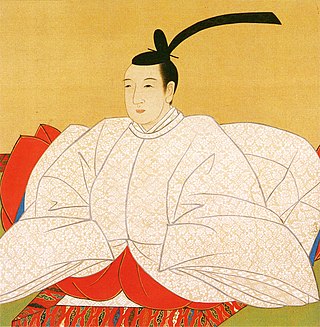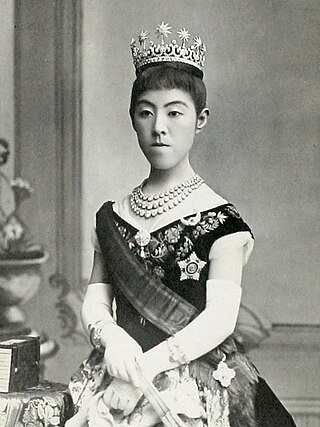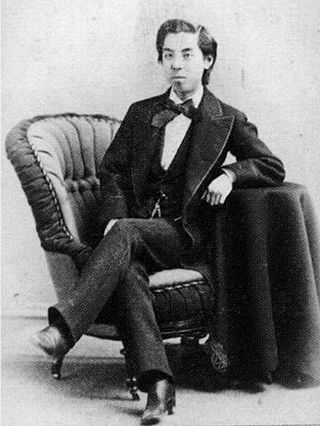This article relies largely or entirely on a single source .(April 2019) |
| |||||
| Decades: | |||||
|---|---|---|---|---|---|
| See also: | Other events of 1852 History of Japan • Timeline • Years | ||||
Events in the year 1852 in Japan .
This article relies largely or entirely on a single source .(April 2019) |
| |||||
| Decades: | |||||
|---|---|---|---|---|---|
| See also: | Other events of 1852 History of Japan • Timeline • Years | ||||
Events in the year 1852 in Japan .

Osahito, posthumously honored as Emperor Kōmei, was the 121st emperor of Japan, according to the traditional order of succession. Kōmei's reign spanned the years from 1846 through 1867, corresponding to the final years of the Edo period.

Ayahito, posthumously honored as Emperor Ninkō, was the 120th emperor of Japan, according to the traditional order of succession. Ninkō's reign spanned the years from 1817 until his death in 1846, and saw further deterioration of the power of the ruling Shōgun. Disasters, which included famine, combined with corruption and increasing Western interference, helped to erode public trust in the bakufu government. Emperor Ninkō revived certain court rituals and practices upon the wishes of his father. However, it is unknown what role, if any, the Emperor had in the turmoil which occurred during his reign.

Keiō was a Japanese era name after Genji and before Meiji. The period spanned the years from May 1865 to October 1868. The reigning emperors were Kōmei-tennō (孝明天皇) and Meiji-tennō (明治天皇).

Kaei (嘉永) was a Japanese era name after Kōka and before Ansei. This period spanned the years from February 1848 through November 1854. The reigning emperor was Kōmei-tennō (孝明天皇).

Kōka (弘化) was a Japanese era name after Tenpō and before Kaei. This period spanned the years from December 1844 through February 1848. The reigning emperors were Ninkō-tennō (仁孝天皇) and Kōmei-tennō (孝明天皇).

Asahiko, Prince Kuni was a member of a collateral line of the Japanese imperial family who played a key role in the Meiji Restoration. Prince Asahiko was an adopted son of Emperor Ninkō and later a close advisor to Emperor Kōmei and Emperor Meiji. He was the great-great-grandfather of the present Emperor of Japan, Naruhito.

Masako Ichijō, who adopted the imperial given name Haruko (美子) in 1867 and was posthumously honoured as Empress Dowager Shōken, was the wife of Emperor Meiji of Japan. She was one of the founders of the Japanese Red Cross Society, whose charity work was known throughout the First Sino-Japanese War.
Daijō Tennō or Dajō Tennō (太上天皇) is a title for an Emperor of Japan who abdicates the Chrysanthemum Throne in favour of a successor.

Prince Yamashina Kikumaro, was the second head of the Yamashina-no-miya, a collateral line of the Japanese imperial family.

Taruhito, Prince Arisugawa was a Japanese career officer in the Imperial Japanese Army, who became the 9th head of the Arisugawa-no-miya (有栖川宮家) line of shinnōke cadet branches of the Imperial Family of Japan on September 9, 1871.
Prince Kitashirakawa Satonari was the founder of a collateral branch of the Japanese imperial family.

Nakayama Yoshiko was a Japanese lady-in-waiting in the court of the Imperial House of Japan. She was a favourite concubine of Emperor Kōmei and the mother of Emperor Meiji.

Prince Kachō Hirotsune of Japan, was the founder of a collateral branch of the Japanese imperial family.
Sakai Tadaaki, also known as Sakai Tadayoshi, was a Japanese daimyō of the Edo period, and he was a prominent shogunal official. He was also known as by his courtesy titles of Shūri-daibu ; as Wakasa-no-kami (1841); and Ukyō-daibu (1862). He was Obama's last daimyō, holding this position until the feudal domains were abolished in 1871.

Mutsuhito, posthumously honored as Emperor Meiji, was the 122nd emperor of Japan according to the traditional order of succession, reigning from 1867 until his death in 1912. His reign is associated with the Meiji Restoration of 1868, which ended the Tokugawa shogunate and began rapid changes that transformed Japan from an isolationist, feudal state to an industrialized world power. Emperor Meiji was the first monarch of the Empire of Japan, and presided over the Meiji era.

Asako Kujō, posthumously honoured as Empress Dowager Eishō, was the consort of Emperor Kōmei of Japan.

Marquess Nakayama Tadayasu was a Japanese nobleman and courtier of the Edo period and then one of the Kazoku of the post-1867 Empire of Japan. He was the father of Nakayama Yoshiko (1836–1907), mother of the Emperor Meiji, who was born and brought up in Nakayama's household. He had the rare honour of being awarded the Order of the Chrysanthemum while he was still alive.
Princess Sumiko was a Japanese princess. She was the head of the Katsura-no-miya from 1863 until 1881.
Events in the year 1867 in Japan. It corresponds to Keiō 2 and Keiō 3 in the Japanese calendar.